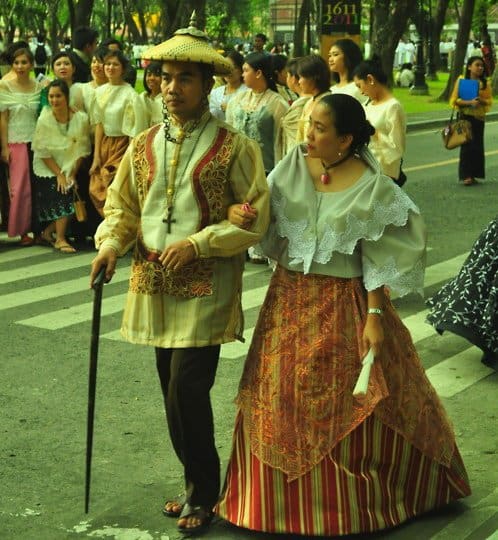The act of Filipino children placing the backs of the hands of elders to their foreheads is called “pagmamano” or simply “mano.” This gesture is a traditional Filipino sign of respect and a way of seeking blessings from elders.

When you step into the Philippines, you’re not just entering a country; you’re immersing yourself in a vibrant tapestry of culture, history, and tradition that spans thousands of islands and centuries of evolution. The Philippines, with its stunning landscapes and warm-hearted people, offers more than just scenic beaches and towering mountains. It presents a rich cultural experience that every traveler should explore and embrace.
A Warm Welcome: Filipino Hospitality

One of the first things you’ll notice upon arrival in the Philippines is the genuine warmth and hospitality of its people. This is not a mere stereotype; it’s an integral part of Filipino culture known as “Bayanihan”—a spirit of communal unity and cooperation. Filipinos are known for their kindness and willingness to help, often going out of their way to make visitors feel at home. It’s not uncommon for locals to invite you to their homes for a meal, treating you as part of the family, even if you’ve just met. This deep-rooted tradition is a reflection of the Filipino value of “pakikisama,” or maintaining harmonious relationships.
A Melting Pot of Influences

The culture of the Philippines is a rich blend of various influences, reflecting its complex and interesting history. The long period of Spanish colonization, which followed centuries of Muslim influenced from the south, followed by American and Japanese occupations, left indelible marks on the country’s customs, traditions, and even language. The Filipino language, Tagalog (and its widely spoken variation, Filipino), is peppered with Spanish words, and many Filipinos are fluent in English—a testament to the American influence.

Religious practices are also a significant part of this cultural mosaic. The Philippines is predominantly Roman Catholic, a legacy of over 300 years of Spanish rule. This influence is evident in the numerous churches that dot the country, some of which are centuries old and hold UNESCO World Heritage status. Festivals such as Sinulog, Ati-Atihan, and Pahiyas celebrate this religious heritage, with vibrant parades, traditional dances, and colorful costumes that bring communities together in joyful reverence.
Festivals: A Celebration of Life and Culture

Speaking of festivals, the Philippines is renowned for its fiestas—grand, colorful celebrations held in every town and city throughout the year. Each festival is unique, often honoring a patron saint or marking a historical event. For instance, Sinulog in Cebu celebrates the Santo Niño (Child Jesus) with a grand street parade featuring participants in elaborate costumes dancing to the rhythm of drums and native gongs. Meanwhile, the Panagbenga Festival in Baguio, also known as the Flower Festival, showcases the region’s blooming flowers with floats adorned in intricate floral designs.

These festivals are not just about fun and entertainment; they are a way for Filipinos to express their identity, preserve their traditions, and pass them on to future generations. For travelers, participating in these events offers a unique insight into the Filipino spirit—a mixture of faith, resilience, and joy.
Cuisine: A Feast for the Senses

Filipino cuisine is as diverse and colorful as its culture. With influences from Malay, Spanish, Chinese, and American cooking, the food in the Philippines offers a delightful blend of flavors that range from sweet to savory, and everything in between. One must-try dish is adobo, often considered the national dish, which is a mouth-watering stew of meat marinated in vinegar, soy sauce, garlic, and spices. Lechon, a whole roasted pig, is a must at any festive gathering, known for its crispy skin and tender meat.
Don’t miss out on the street food scene, where you can sample local delicacies like balut (a fertilized duck egg), isaw (grilled chicken intestines), and taho (sweetened tofu with tapioca pearls). These may challenge your palate, but they are quintessential experiences of Filipino food culture.
Family and Community: The Core of Filipino Life

Family is the cornerstone of Filipino society. Filipinos have close-knit family ties, often extending to a large network of relatives who regularly gather for reunions and celebrations. The concept of “utang na loob,” or debt of gratitude, is deeply ingrained, where family members support each other unconditionally, creating a strong sense of loyalty and responsibility.
For travelers, this emphasis on family extends to how they are treated as guests. When you visit a Filipino home, expect to be treated with utmost respect and generosity. Sharing food, stories, and laughter around the table is a cherished tradition that reflects the importance of family in Filipino life.
Indigenous Traditions and Modern Influences

While the Philippines is rapidly modernizing, many indigenous traditions still thrive, especially in rural areas. The Igorot people of the Cordillera region, for example, maintain ancient rituals and practices, including the famous Ifugao rice terraces—a UNESCO World Heritage site and a testament to the ingenuity and harmony of these people with nature. Similarly, the Mangyan tribes of Mindoro island continue to practice their distinct way of life, crafting intricate woven fabrics and living in close connection with the environment.
These indigenous cultures offer a window into the Philippines’ pre-colonial past and provide a unique contrast to the urbanized, westernized lifestyle seen in cities like Manila and Cebu.
The Filipino Smile

Above all, the most enduring impression you will leave the Philippines with is the smile of its people. The Filipino smile is legendary—not just a facial expression, but a reflection of a culture that values happiness, optimism, and a positive outlook on life, even in the face of adversity. This resilience and cheerful demeanor, often called “malasakit,” or caring for others, is what makes the Philippines more than just a travel destination—it’s a place that touches the heart.
My own personal experiences

I’d definitely say that smiles, warmth and hospitality are the first things that really stood out to me when I arrived. On the other hand, over time this was somewhat tarnished by yet another child’s hand cupped and outstretched and hearing the words, “Give me money!” They’d end up spending it on candy or gambling, so I stopped giving there. Or one day would be a howl of fun when I bought a bottle of cheap local rum for a group of gents, but the next evening when I failed to produce again, I was greeted with disinterest and scowls.

Loving spicy food, my favourite being Thai, Mexican and Indian, I found Filipino food quite bland and boring, but yes, the chicken adobo is a good staple nourishment.

The festivals are definitely a cheery event, but personally I think it would be nice to see more of their much older, animalistic roots.
Their religious fervour and dedicated is heart warming if you are a believer, but can seem often very superficial when you see how locals can quickly react with scathing envy and petty bickering over pennies.
Their sense of family and community is warm indeed.
Overall, after living here for almost a decade after traveling to more than 40 countries, I definitely love the place, people, culture, a big thumbs up to the climate, and who can complain about more than 7,000 islands with white sand beaches, many of them desolate?

I also consider it a very safe place and a great country to raise children and start a family. Food is organic and abundant, as bountiful as the warmth of the Filipino heart.
Conclusion
Traveling to the Philippines is an opportunity to experience a culture rich in history, traditions, and diversity. Whether you’re attending a lively fiesta, sharing a meal with a local family, or exploring the ancient rice terraces, you’ll find that the true beauty of the Philippines lies not just in its landscapes, but in the warmth, resilience, and spirit of its people. So pack your bags and get ready to discover a country where every smile tells a story, and every tradition is an invitation to belong.
Home » Various » promo »You may also like:
We are a family operation managing private custom boat tours in the beautiful Palawan area, and are happy to help travelers with their plans through the country, having traveled a lot of it ourselves and planning to visit it all.


